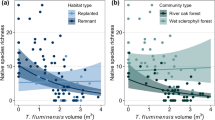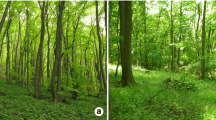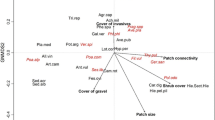Abstract
The Atlantic forest is among the hottest hotspots for biodiversity conservation. Within this biome, inselbergs are isolated granitic and gneiss rocks that rise sharply above the lowland surrounding forests. Due to prevailing stressful conditions and resource paucity of inselbergs, distinguished plant communities are formed in these rocky-associated vegetation, which comprise unusually high levels of endemic and threatened species. Here, we evaluated the importance of competitiveness:stress-tolerance:ruderalism ecological strategies in different vegetation patches on the inselberg, tested for a connection between patch structure and functional traits, and compared the variation in functional traits between native and an exotic species, which represents a major threat to inselberg communities. Despite the stressful conditions of inselbergs, we found a relatively high diversity of ecological strategies, but most species and patches lied between the S and C strategy. The invasive Melinis repens, in turn, was functionally distinctive from native communities, with the predominance of traits associated with ruderalism. We also found that most functional traits significantly correlated with at least one environmental driver, highlighting their role in structuring plant communities in this heterogeneous environment. Since inselberg patches were spatially heterogeneous, and the variation in resource availability implies in favouring different ecological strategies, some patch types were more invasive-prone than others. Our data provide significant advances for identifying the environmental drivers of biological invasion in resource-limited environments. We argue that further trait-based approaches will become critical for developing conservation and management strategies for inselberg plant communities, especially in the context of rapid habitat loss and fragmentation of the Atlantic forest.




Similar content being viewed by others
References
Alvares CA, Stape JL, Sentelhas PC, Gonçalves JLM, Sparovek G (2013) Köppen’s climate classification map for Brazil. Meteorol Z 22:711–728
Arditti J (1979) Aspects of the physiology of orchids. Academic Press, London
Barbosa NPU, Fernandes GW, Carneiro MAA, Júnior LAC (2010) Distribution of non-native invasive species and soil properties in proximity to paved roads and unpaved roads in a quartzitic mountainous grassland of southeastern Brazil (rupestrian fields). Biol Invasions 12:3745–3755
Barthlott W, Gröger A, Porembski S (1993) Some remarks on the vegetation of tropical inselbergs: diversity and ecological differentiation. Biogeographica 69:105–124
Bremer B, Bremer K, Chase MW et al (2009) An update of the Angiosperm Phylogeny Group classification for the orders and families of flowering plants: APG III. Bot J Linn Soc 161:105–121
Burke A (2003) Inselbergs in a changing world—global trends. Divers Distrib 9:375–383
Cerabolini BEL, Brusa G, Ceriani RM, de Andreis R, Luzzaro A, Pierce S (2010) Can CSR classification be generally applied outside Britain? Plant Ecol 210:253–261
Chapin FS III, Zavaleta ES, Eviner VT, Naylor RL, Vitousek PM, Reynolds HL, Hooper DU, Lavorel S, Sala OE, Hobbie SE, Mack MC, Díaz S (2000) Consequences of changing biodiversity. Nature 405:234–242
Chessel D, Dufour AB, Thioulouse J (2004) The ade4 package-I-one-table methods. R news 4:5–10
David AS, Menges ES (2011) Microhabitat preference constrains invasive spread of non-native natal grass (Melinis repens). Biol Invasions 13:2309–2322
de Bello F, Lavorel S, Díaz S, Harrington R, Cornelissen JHC, Bardgett RD, Berg MP, Cipriotti P, Feld CK, Hering D (2010) Towards an assessment of multiple ecosystem processes and services via functional traits. Biodivers Conserv 19:2873–2893
Díaz S, Cabido M (1997) Plant functional types and ecosystem function in relation to global change. J Veg Sci 8:463–474
Díaz S, Cabido M (2001) Vive la différence: plant functional diversity matters to ecosystem processes. Trends Ecol Evol 16:646–655
Díaz S, Hodgson JG, Thompson K et al (2004) The plant traits that drive ecosystems: evidence from three continents. J Veg Sci 15:295–304
Dolédec S, Chessel D, ter Braak CJF, Champely S (1996) Matching species traits to environmental variables: a new three-table ordination method. Environ Ecol Stat 3:143–166
Dray S, Dufour AB (2007) The ade4 package: implementing the duality diagram for ecologists. J Stat Softw 22:1–20
Dray S, Choler P, Dolédec S, Peres-Neto PR, Thuiller W, Pavoine S, ter Braak CJF (2014) Combining the fourth-corner and the RLQ methods for assessing trait responses to environmental variation. Ecology 95:14–21
Drenovsky RE, Grewell BJ, D’Antonio CM, Funk JL, James JJ, Molinari N, Parker IM, Richards CL (2012) A functional trait perspective on plant invasion. Ann Bot 110:141–153
Fridley JD, Grime JP, Askew AP, Moser B, Stevens CJ (2011) Soil heterogeneity buffers community response to climate change in species-rich grassland. Glob Change Biol 17:2002–2011
Funk JL (2013) The physiology of invasive species in low-resource environments. Conserv Physiol. doi:10.1093/conphys/cot026
Galindo-Leal C, Jacobsen TR, Langhammer PF, Olivieri S (2003) State of the hotspots: the dynamics of biodiversity loss. In: Galindo-Leal C, de Câmara IG (eds) The Atlantic Forest of South America: biodiversity status, threats, and outlook. Center for Applied Biodiversity Science and Island Press, Washington, pp 12–23
Grime JP (2001) Plant strategies, vegetation processes, and ecosystem properties, 2nd edn. Wiley, Chichester
Grime JP, Thompson K, Hunt R et al (1997) Integrated screening validates primary axes of specialisation in plants. Oikos 79:259–281
Hopper SD (2009) OCBIL theory: towards an integrated understanding of the evolution, ecology and conservation of biodiversity on old, climatically buffered, infertile landscapes. Plant Soil 322:49–86
Hopper SD, Brown AP, Marchant NG (1997) Plants of Western Australian granite outcrops. J R Soc West Aust 80:141–158
Hussey BMJ (1993) Naturalised plants on the southern slopes of the western end of the Helena Valley, Western Australia. West Aust Nat 19:219–240
Huston MA (1997) Hidden treatments in ecological experiments: re-evaluating the ecosystem function of biodiversity. Oecologia 110:449–460
INMET (1992) Normais climatológicas (1961-1990). National Institute of Meteorology, Brasília
Jacobi CM, do Carmo FF, Vincent RC, Stehmann JR (2007) Plant communities on ironstone outcrops: a diverse and endangered Brazilian ecosystem. Biodivers Conserv 16:2185–2200
Joly CA, Metzger JP, Tabarelli M (2014) Experiences from the Brazilian Atlantic forest: ecological findings and conservation initiatives. New Phytol 204:459–473
Leão TC, Fonseca CR, Peres CA, Tabarelli M (2014) Predicting extinction risk of Brazilian Atlantic forest angiosperms. Conserv Biol 28:1349–1359
Legendre P, Galzin R, HarmelinVivien ML (1997) Relating behavior to habitat: solutions to the fourth-corner problem. Ecology 78:547–562
Loreau M (1998) Biodiversity and ecosystem functioning: a mechanistic model. Proc Natl Acad Sci USA 95:5632–5636
Loreau M (2000) Biodiversity and ecosystem functioning: recent theoretical advances. Oikos 91:3–17
Martinelli G (2007) Mountain biodiversity in Brazil. Braz J Bot 30:587–597
Martinelli G, Moraes MA (2013) Red book of Brazilian flora. Jardim Botânico do Rio de Janeiro. http://cncflora.jbrj.gov.br. Accessed 26 June 2014
Meirelles ST, Pivello VR, Joly CA (1999) The vegetation of granite rock outcrops in Rio de Janeiro, Brazil, and the need for its protection. Environ Conserv 26:10–20
Moles AT, Ackerly DD, Webb CO, Tweddle JC, Dickie JB, Westoby M (2005) A brief history of seed size. Science 307:576–580
Myers N, Mittermeier RA, Mittermeier CG, da Fonseca GAB, Kent J (2000) Biodiversity hotspots for conservation priorities. Nature 403:853–858
Negreiros D, Le Stradic S, Fernandes GW, Rennó HC (2014) CSR analysis of plant functional types in highly diverse tropical grasslands of harsh environments. Plant Ecol 215:379–388
Oliveira TD, Ribeiro MC, Costa ILL, Faria F, Figueira JEC (2004) Estabelecimento de espécies vegetais em um inselberg granítico de Mata Atlântica. Rev Estud Biol 26:17–24
Oliveira-Filho AT, Fontes MAL (2000) Patterns of floristic differentiation among Atlantic forests in southeastern Brazil and the influence of climate. Biotropica 32:793–810
Ordonez A, Olff H (2013) Do alien plant species profit more from high resource supply than natives? a trait-based analysis. Glob Ecol Biogeogr 22:648–658
Pavoine S, Vela E, Gachet S, de Belair G, Bonsall MB (2011) Linking patterns in phylogeny, traits, abiotic variables and space: a novel approach to linking environmental filtering and plant community assembly. J Ecol 99:165–175
Pérez-Harguindeguy N, Díaz S, Garnier E et al (2013) New handbook for standardised measurement of plant functional traits worldwide. Aust J Bot 61:167–234
Pierce S, Luzzaro A, Caccianiga M, Ceriani RM, Cerabolini B (2007) Disturbance is the principal α-scale filter determining niche differentiation, coexistence and biodiversity in an alpine community. J Ecol 95:698–706
Pierce S, Brusa G, Vagge I, Cerabolini BEL (2013) Allocating CSR plant functional types: the use of leaf economics and size traits to classify woody and herbaceous vascular plants. Funct Ecol 27:1002–1010
Pigott JP (2000) Environmental weeds and granite outcrops: possible solutions in the “too hard basket”. J R Soc West Aust 83:135–137
Pigott JP, Sage LW (1997) Remnant vegetation, priority flora and weed invasions at Yilliminning Rock, Narrogin, Western Australia. J R Soc West Aust 80:201–208
Porembski S (2000) The invasibility of tropical granite outcrops (‘inselbergs’) by exotic weeds. J R Soc Wes Aust 83:131–137
Porembski S (2007) Tropical inselbergs: habitat types, adaptive strategies and diversity patterns. Braz J Bot 30:579–586
Porembski S, Barthlott W (2000) Granitic and gneissic outcrops (inselbergs) as centers of diversity for desiccation-tolerant vascular plants. Plant Ecol 151:19–28
Porembski S, Seine R, Barthlott W (1997) Inselberg vegetation and the biodiversity of granite outcrops. J R Soc West Aust 80:193–199
Porembski S, Becker U, Seine R (2000) Islands on islands: habitats on inselbergs. In: Porembski S, Barthlott W (eds) Inselbergs—biotic diversity of isolated rock outcrops in tropical and temperate regions. Ecological studies. Springer, Berlin, pp 49–67
Quinn GP, Keough MJ (2002) Experimental design and data analysis for biologists. Cambridge University Press, Cambridge
Reich PB (2014) The world-wide ‘fast-slow’ plant economics spectrum: a traits manifesto. J Ecol 102:275–301
Ribeiro KT, Medina BMO (2002) Estrutura, dinâmica e biogeografia das ilhas de vegetação sobre rocha do Planalto do Itatiaia, RJ. Boletim do Parque Nacional do Itatiaia 10:1–82
Ribeiro KT, Medina BMO, Scarano FR (2007) Species composition and biogeographic relations of the rock outcrop flora on the high plateau of Itatiaia, SE-Brazil. Braz J Bot 30:623–639
R Development Core Team (2012) R: a language and environment for statistical computing. R Foundation for Statistical Computing, Vienna, Austria. www.r-project.org. Accessed 26 Aug 2012
Safford HD, Martinelli G (2000) Southeast Brazil. In: Porembski S, Barthlott W (eds) Inselbergs—biotic diversity of isolated rock outcrops in tropical and temperate regions. Ecological studies. Springer, Berlin, pp 339–389
Scarano FR (2002) Structure, function and floristic relationships of plant communities in stressful habitats marginal to the Brazilian Atlantic rainforest. Ann Bot 90:517–524
Seine R, Becker U, Porembksi S, Follman G, Barthlott W (1998) Vegetation of inselbergs in Zimbabwe. Edinb J Bot 55:267–293
Silva DM, Batalha MA (2011) Defense syndromes against herbivory in a cerrado plant community. Plant Ecol 212:181–193
Tabarelli M, Silva JMC, Gascon C (2004) Forest fragmentation, synergisms and the impoverishment of neotropical forests. Biodivers Conserv 13:1419–1425
Tabarelli M, Pinto LP, Silva JMC, Hirota M, Bedê L (2005) Challenges and opportunities for Biodiversity conservation in the Brazilian Atlantic forest. Conserv Biol 19:695–700
Tecco PA, Díaz S, Cabido M, Urcelay C (2010) Functional traits of alien plants across contrasting climatic and land-use regimes: do aliens join the locals or try harder than them? J Ecol 98:17–27
van Kleunen M, Weber E, Fischer M (2010) A meta-analysis of trait differences between invasive and non-invasive plant species. Ecol Lett 13:235–245
Veloso HP, Rangel Filho ALR, Lima JCA (1991) Classificação da vegetação brasileira, adaptada a um sistema universal. Fundação Instituto Brasileiro de Geografia e Estatística, Rio de Janeiro
Westoby M (1998) A leaf-height-seed (LHS) plant ecology strategy scheme. Plant Soil 199:213–227
Westoby M, Falster DS, Moles AT, Vesk PA, Wright IJ (2002) Plant ecological strategies: some leading dimensions of variation between species. Annu Rev Ecol Syst 33:125–159
Wright IJ, Reich PB, Westoby M et al (2004) The worldwide leaf economics spectrum. Nature 428:821–827
Wyatt R (1997) Reproductive ecology of granite outcrop plants from the south-eastern United States. J R Soc West Aust 80:123–129
Zenni RD, Ziller SR (2011) An overview of invasive plants in Brazil. Braz J Bot 34:431–446
Acknowledgments
We thank Ana L. Fonseca, Marcelo Amorim, Marcelo Fonseca, Theo Mota, Luiza C. Martins, Lucas, Eliane and Caique for logistical support and help in the field work. We express our gratitude to the Addiny family for kindly providing permission to do field work on its property, and also to J.P. Lemos-Filho and G.W. Fernandes that gently loaned us equipments, S. Dolédec who gave statistical advice and F. de Bello, B.H.P. Rosado and F.F. Carmo that provided insightful discussions. We are also thankful for the botanical specialists who gently helped with many identifications, especially N.F.O. Mota and P.L. Viana. Finally, we thank the Grants from the CNPq (Conselho Nacional de Desenvolvimento Científico e Tecnológico, 163020/2013-2, 482720/2012), CAPES (Coordenação de Aperfeiçoamento de Pessoal de Nível Superior) and FAPEMIG (Fundação de Amparo à Pesquisa de Minas Gerais). This study was in partial fulfillment of the master requirements of L.F.A. de Paula in Plant Biology, who received a scholarship from CNPq. F.A.O. Silveira receives a research productivity fellowship from CNPq.
Conflict of interest
The authors declare that they have no conflict of interest.
Author information
Authors and Affiliations
Corresponding author
Additional information
Communicated by Jefferson Prado and Pedro V. Eisenlohr.
Electronic supplementary material
Below is the link to the electronic supplementary material.
Rights and permissions
About this article
Cite this article
de Paula, L.F.A., Negreiros, D., Azevedo, L.O. et al. Functional ecology as a missing link for conservation of a resource-limited flora in the Atlantic forest. Biodivers Conserv 24, 2239–2253 (2015). https://doi.org/10.1007/s10531-015-0904-x
Received:
Revised:
Accepted:
Published:
Issue Date:
DOI: https://doi.org/10.1007/s10531-015-0904-x




